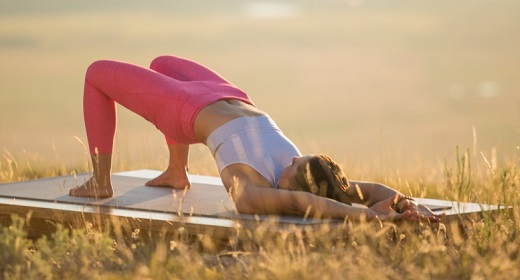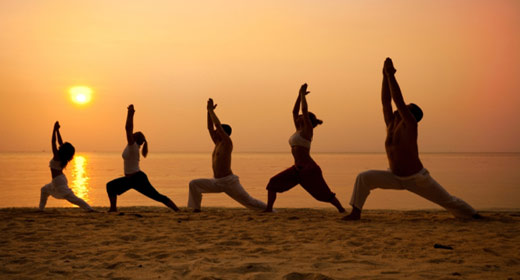Ah, bridge pose — it can be energizing or restorative depending on the setting…
Bridge pose stretches the neck, creates space in the spine, opens the chest, and stretches the hip flexors. It is an inversion, because your heart is above your head, allowing blood to complete its circuit in the body.
Bridge pose or supported bridge pose can reinforce lung health and be beneficial for individuals with high blood pressure. You can either use your internal support to lift up your hips or rest them safely on a block or bolster to passively absorb this pose’s benefits.
Sanskrit Translation:
setu — “bridge”
bandha — “lock”
sarva — “all”
anga — “limb”
asana — “pose”
STEP 1: Lay Back
Begin by lying on your back. Bend your knees and place your feet flat on the ground with your knees directly over your ankles. The shoulders should feel evenly planted on your mat. The back of your head is heavy on the mat in a neutral position to preserve the natural arch of the cervical spine (the neck area).
STEP 2: Lift Up
As you inhale, without engaging through the buttocks, lift the hips evenly up in space. Make sure there is a line from the knees to the hips to the shoulders and you are not pressing up with the buttocks and hardening the groins. Stay soft in those areas, but maintain the knees stacking over the ankles.
STEP 3: Create Space with Breath
Walk your shoulder blades under the back of the heart and if accessible, interlace your hands underneath the sacrum. Press the upper arm bones into the mat, as you are doing with the feet, and puff the chest towards the chin as you draw the chin away from the chest. Keep the tailbone lengthening as the heels draw back towards the head. Breathe, repeat, or slowly and mindfully exit as you entered.
Target Area:
Chest, Spine, Neck, Hips, Hamstrings, Buttocks, Spine
Therapeutic Focus:
Very calming for the nervous system, alleviates stress and mild depression. Tones and stimulates the abdominal organs while stimulating the lungs.
Benefits:
·Increases circulation in the body.
·Calms the brain and central nervous system.
·Reduces backache and headache.
Props & Modifications:
Use a block or bolster under the sacrum. There are three levels to a block that can support you. A bolster can be placed perpendicularly, directly under the sacrum or hips.
*We recommend that you do not rely solely on the information presented and that you consult your health care professional before making any changes to your regular health care routine.









































